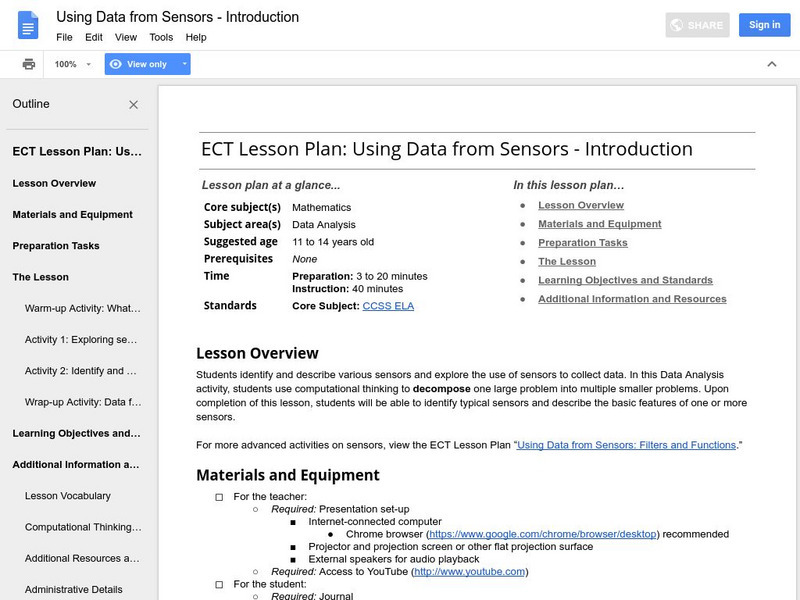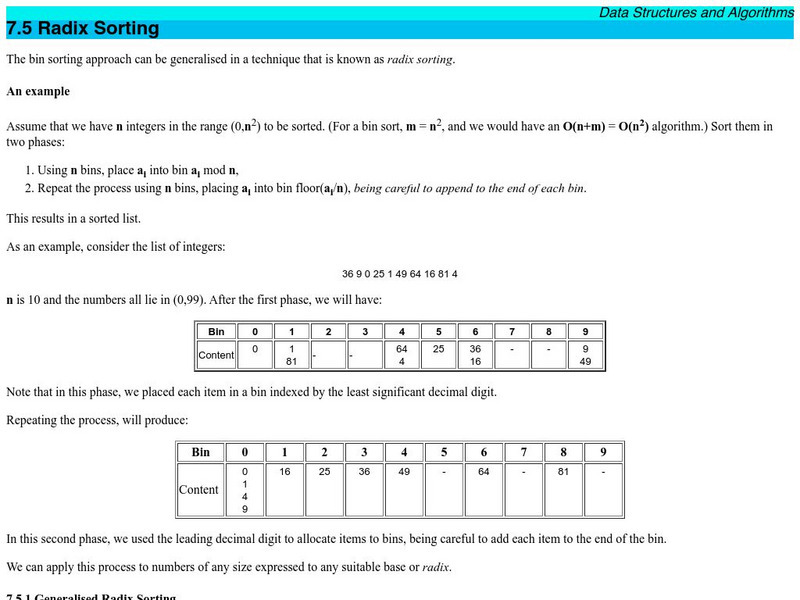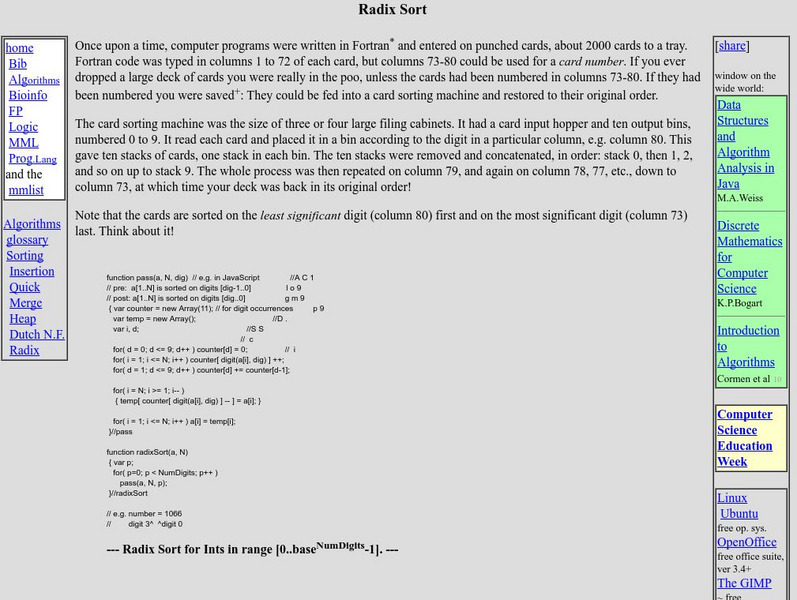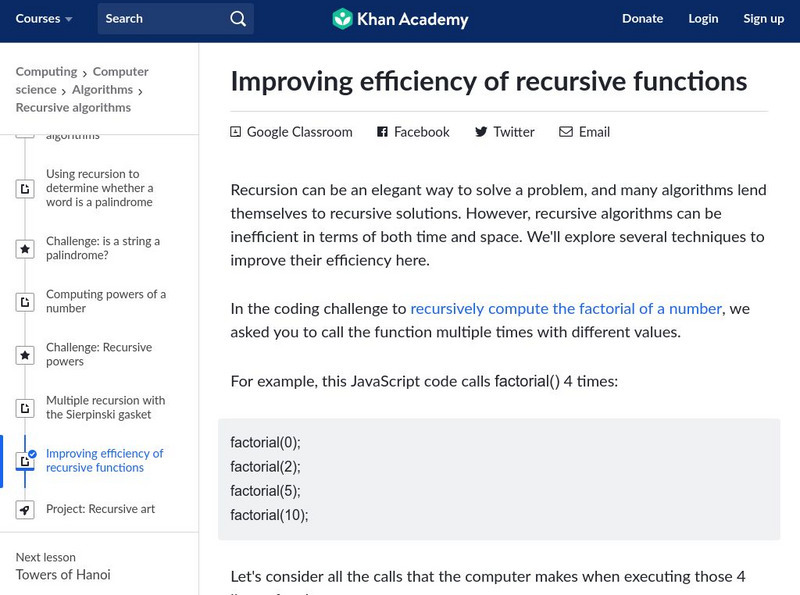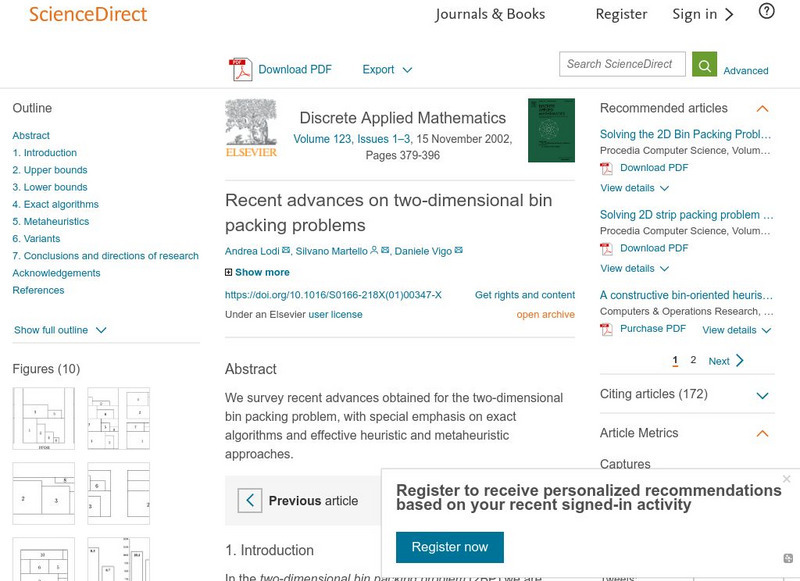Hi, what do you want to do?
Google
Google for Education: Using Data From Sensors
Learners analyze data gathered from sensors and develop filtering algorithms for anomalies and outliers, then use these algorithms to make decisions on sensor data as it is being collected.
University of Regina (Canada)
University of Regina: Math Central: Greatest Common Divisor and Least Common Multiple
Learn about the greatest common divisor, the least common multiple, and the Euclidean Algorithm. This resource gives a description of each of these concepts, accompanied by several examples.
Massachusetts Institute of Technology
Mit: Open Course Ware: Great Ideas in Theoretical Computer Science
A complete course on theoretical Computer Science presented at the college undergraduate level. The course attempts to describe Computer Science beyond the computer, focusing on mathematical tools, complex systems and classic problems,...
University of Auckland School of Computer Science
Morris: Radix Sorting
A detailed description of the Radix sort algorithm, including a code solution written in the C programming language and an interactive animation / visualization of the sort at work.
University of Auckland School of Computer Science
Morris: Binary Search
A description of finding data in an ordered collection using a binary search algorithm.
Utah Education Network
Uen: Partial Quotient
Detailed lesson plan explains how to use the partial quotients algorithm for solving division problems and understanding the process involved.
University of Canterbury
University of Canterbury: Cs Unplugged: Minimal Spanning Trees
This puzzle shows students the decisions involved in linking a network between houses in a muddy city. It can lead on to a discussion of minimal spanning tree algorithms for optimizing networks.
Paul Dawkins
Paul's Online Notes: Algebra: Dividing Polynomials
Detailed math tutorial features notes and examples that take a look at the basics dividing polynomials, introduces synthetic division, and gives the Division Algorithm.
Other
California Polytechnic State University: Pseudocode Standard
An in-depth discussion of the algorithm design language known as pseudocode.
Khan Academy
Khan Academy: Spin Off of Project: Recursive Art
A practice project applying recursive algorithms.
Khan Academy
Khan Academy: Improving Efficiency of Recursive Functions
Learn how to improve the efficiency of recursive algorithms.
Khan Academy
Khan Academy: Overview of Quicksort
Learn how a quicksort uses divide-and-conquer, and so it's a recursive algorithm.
Khan Academy
Khan Academy: Binary Search
Learn how binary search is an efficient algorithm for finding an item from a sorted list of items.
Science Buddies
Science Buddies: Devising an Algorithm for Solving Rubik's Cube
If you're the kind of person who has taken apart your Rubik's cube in order to grease the inside parts so it will move more smoothly, this could be a great project for you. This will show you three sets of move sequences that accomplish...
TeachEngineering
Teach Engineering: Java Programming of Ocr
Student groups use the Java programming language to implement the algorithms for optical character recognition (OCR) that they developed in the associated lesson. The ultimate goal is to produce computer code that recognizes a digit on a...
REMC Association of Michigan
Remc Association of Michigan: 21 Things4 Students: 21. Computational Thinking
Computational thinking can be used to take a complex problem, understand what the problem is and develop possible solutions to solve or explain it. In these six Quest, students will learn about the four stages of computational thinking:...
Other
Medium: Decision Trees Algorithms
Decision trees are used for both classification and regression problems, this story we talk about classification.
Khan Academy
Khan Academy: Where to Go From Here
After learning about algorithms, find out what to learn next.
Khan Academy
Khan Academy: A Guessing Game
This Khan Academy resource is an article about a game that gives you an idea of how different algorithms for the same problem can have wildly different efficiencies. The computer is going to randomly select an integer from 1 to 15....
Other
University of Birmingham: "Top Down" and "Bottom Up" Design
Describes bottom-up design methodology and differentiates it from top-down procedures. Contains some questions to help choose a particular methodology.
Other
Science Direct: Recent Advances on Two Dimensional Bin Packing Problems
This paper surveys recent advances obtained for the two-dimensional bin packing problem, with special emphasis on exact algorithms and effective heuristic and metaheuristic approaches.
Mathigon
Mathigon: Graphs and Networks: The Travelling Salesman Problem
This lesson focuses on the traveling salesman problem which involves finding paths through a city without backtracking. While no algorithm has been found to do that for all cities, there are algorithms that help somewhat. They are...
Khan Academy
Khan Academy: Yann Dauphin, Researcher and Bass Player
Hi, I'm Yann Dauphin. I design and code artificial intelligence algorithms that can learn from examples. They are like programs that can program themselves. I spend most of my time discussing new ideas for algorithms, coding in Python,...
Other popular searches
- Numerical Algorithms
- Division Algorithm
- Multiplication Algorithms
- Addition With Algorithms
- Addition Algorithms
- Subtraction Algorithms
- Standard Algorithm
- Math With Algorithms
- Partial Products Algorithm
- Partial Sums Algorithm
- Adding Integers Algorithm
- Dividing Algorithm





